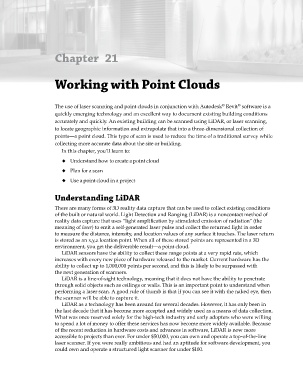Page 881 - Divyank Tyagi
P. 881
Chapter 21
Working with Point Clouds
®
The use of laser scanning and point clouds in conjunction with Autodesk Revit software is a
®
quickly emerging technology and an excellent way to document existing building conditions
accurately and quickly. An existing building can be scanned using LiDAR, or laser scanning,
to locate geographic information and extrapolate that into a three-dimensional collection of
points—a point cloud. This type of scan is used to reduce the time of a traditional survey while
collecting more accurate data about the site or building.
In this chapter, you’ll learn to:
◆ ◆◆ Understand how to create a point cloud
◆ ◆◆ Plan for a scan
◆ ◆◆ Use a point cloud in a project
Understanding LiDAR
There are many forms of 3D reality data capture that can be used to collect existing conditions
of the built or natural world. Light Detection and Ranging (LiDAR) is a noncontact method of
reality data capture that uses “light amplification by stimulated emission of radiation” (the
meaning of laser) to emit a self-generated laser pulse and collect the returned light in order
to measure the distance, intensity, and location values of any surface it touches. The laser return
is stored as an x,y,z location point. When all of these stored points are represented in a 3D
environment, you get the deliverable result—a point cloud.
LiDAR sensors have the ability to collect these range points at a very rapid rate, which
increases with every new piece of hardware released to the market. Current hardware has the
ability to collect up to 1,000,000 points per second, and this is likely to be surpassed with
the next generation of scanners.
LiDAR is a line-of-sight technology, meaning that it does not have the ability to penetrate
through solid objects such as ceilings or walls. This is an important point to understand when
performing a laser scan. A good rule of thumb is that if you can see it with the naked eye, then
the scanner will be able to capture it.
LiDAR as a technology has been around for several decades. However, it has only been in
the last decade that it has become more accepted and widely used as a means of data collection.
What was once reserved solely for the high-tech industry and early adopters who were willing
to spend a lot of money to offer these services has now become more widely available. Because
of the recent reduction in hardware costs and advances in software, LiDAR is now more
accessible to projects than ever. For under $50,000, you can own and operate a top-of-the-line
laser scanner. If you were really ambitious and had an aptitude for software development, you
could own and operate a structured light scanner for under $100.
c21.indd 847 5/3/2014 12:05:39 PM

